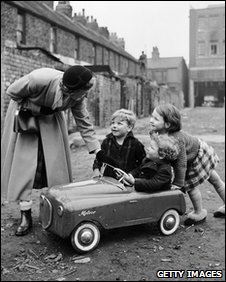|
FIND
OUT MORE... |
Hop,
Skip and
Jump:
The
Story of
Children's
Play
begins
on BBC
Four at
2100
GMT,
Tuesday
8
December
|
|
|
|
British children's play has been transformed in the last 100
years. Up to the 1960s there were few children who didn't spend much of
their free time outdoors, playing in the fields, parks, streets, back
alleys, old bombsites and local beauty spots.
This play was unsupervised by mum or dad and children were free
to go on adventures far from home. Sadly this world of independent
child's play has today largely vanished. One of the important reasons
for this decline is the inexorable rise of stranger danger and child
abduction in modern Britain.
It was in the mid 1960s that this new threat to children's
freedom really took hold of the popular imagination. Child murderers Ian
Brady and Myra Hindley helped change the nation's attitude towards
children's outdoors play. Their sadistic crimes became one of the most
sensational television news stories of the 60s.
The impact this had on children's play is vividly recalled by
many growing at the time.
"I still remember the feelings of terror at seeing Myra Hindley's
face on the news, there was a kind of loss of innocence, you didn't feel
safe after that," says Lancashire boy Steve Wakefield, born in 1955. "Up
until then parents didn't worry too much about where you went and what
time you came home. But afterwards they wanted to keep you in the street
and if you weren't home by the time it was getting dark they were really
concerned and you got into trouble with them."
The fear that it was unwise to allow children to play outdoors
without parental supervision was heightened by some other major social
changes that were increasing dangers on the streets. A huge rise in car
ownership and road traffic proved a big threat to children's safety and
to the way working class communities used their street as a playground.
Houses for high-rises
From the late '50s onwards traffic accidents involving children
playing ball games in their street increased steadily. Slum clearance
and housing improvement schemes inadvertently added to the loss of a
safe outdoor play space for children. They swept away many thousands of
Victorian terraced streets where children had once played, to replace
them with high-rise estates.
For generations neighbours and extended family members had kept
an eye on children playing in the streets, stopping them from getting
into serious trouble and checking on any strangers passing by. Modern
high-rise estates broke up extended families and made this kind of
informal policing of children's play virtually impossible. With no adult
supervision the opportunities for child molesters and paedophiles
increased.
There are few reliable statistics on stranger danger and the
increase in child molestation and abduction. It can be said with
certainty though that the number of reported cases remained extremely
small. A much greater threat to children's lives was road traffic
accidents - made worse by the increasing number of parents who began
driving their children to and from school in order to protect them from
the dangers of the outside world.
In parents' minds however child abduction often appears a greater
and more insidious threat. The flasher at the school gates and sexually
motivated attacks on children are nothing new, but in the television age
these fears have been fuelled by intense media coverage of stories of
child sexual abuse, abduction and murder.
The James Bulger case in 1993, the abduction and murder of Holly
Wells and Jessica Chapman in Soham village in 2002, and the Madeleine McCann
disappearance in 2007 are three of the most dramatic examples.
All had a huge impact on attitudes of parents, making them more inclined
to keep children indoors and to carefully monitor their children's
outdoor activities.
Fat, angry, isolated
There is little doubt that parental fears of stranger danger have
been an important factor that has helped drive a generation of children
indoors. Recent surveys show that most children spend much more of their
free time playing indoors than outdoors - a complete reversal of the
play habits of children in the 1950s and before.
|
If you were losing you'd go in to Mum but she had no
sympathy and say sort it out yourself - 10 minutes later
you'd be out on the streets again Laura Hopkins |
Growing affluence and the child-centred society has certainly not
brought with it a richer outdoor play experience for children. The
physical and psychological consequences of this lost world of children's
play are now beginning to be felt, most obviously with the well
documented increase in child obesity, child aggression and the isolation
of children who now spend most of their free time indoors.
Quite apart from the health benefits of children spending free
time playing running, chasing and hiding games in the streets and
fields, independent play also taught them important social skills. There
were inevitably disagreements and upsets over who were the winners and
losers of all the games, but resolving them without parental
interference helped the children grow up.
As Laura Hopkins, 60, from Manchester remembers: "If you were
losing you'd go in and complain to Mum but she had no sympathy for you
because she'd know it was just a bit of a disagreement, she'd say sort
it out yourself. So 10 minutes later you'd be out on the streets again
and you learned a lesson from that." |



